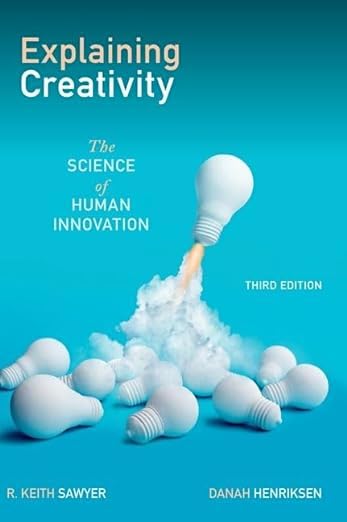UNC School of Education faculty member Keith Sawyer, Ph.D., co-authored the third edition of “Explaining Creativity: The Science of Human Innovation.” The comprehensive textbook analyzes the full spectrum of creative thinking, exploring the underlying cognitive processes, practical applications, and the social and cultural factors that influence creativity.
Published in January 2024 by Oxford University Press, the book, co-authored with Danah Henriksen, Ph.D., of Arizona State University, examines the latest research on various aspects of creativity and how readers will gain insights into thinking processes, personality traits, cultural influences, mental health considerations, group dynamics, the impact of technology, and the power of self-belief.
“Explaining Creativity” goes beyond theory, showcasing creativity across diverse fields like the arts, science, theater, music, and writing. In his undergraduate “Psychology of Creativity” course at the University of North Carolina at Chapel Hill, Sawyer employs “Explaining Creativity” to offer students a comprehensive understanding of creativity through this multifaceted approach.
Sawyer’s lifelong fascination with creativity began in high school with his involvement in improvisational jazz piano groups. This passion fueled his research focus on group improvisation, where he studied jazz ensembles and Chicago improv theater companies. His central question: What makes some groups more creatively successful?
Through qualitative research methods, Sawyer, the Morgan Distinguished Professor in Educational Innovations, analyzes the dynamic interactions within these creative ensembles. His work has revealed the common threads that bind successful creative groups, regardless of their domain.
Sawyer translates this research into practical applications for the classroom — highlighting that by incorporating guided improvisation, teachers can create a learning environment that caters to the unique needs of each student.

Below in a Q&A, Sawyer delves deeper into the book’s exploration of creativity through the lens of psychology and how the book integrates a range of research to provide an understanding of human innovation and the secrets behind the transformative works of others.
What inspired you to write the third edition of “Explaining Creativity: The Science of Human Innovation,” and how has the landscape of creativity research evolved since the second edition in 2012?
The science of creativity has moved forward quite a bit in the past 12 years. It’s an interdisciplinary field, with scholars from not only psychology but also business, sociology, and even computer science and neuroscience. My co-author and I added three new chapters to review important and growing research areas: creative self-beliefs, creativity and mental health, and technology and creativity.
How do you see your book contributing to the collaboration between different scientific fields and fostering a more holistic understanding of creativity? Are there specific chapters or concepts that highlight the intersectionality of creativity across various disciplines?
Researchers are naturally very focused on their own specialized topic, and they sometimes don’t have the time to stay on top of what’s going on in other fields. That’s why a lot of books about creativity are specialized.
I wanted to write a book that brought all of the different research threads together, because I think it brings a more powerful perspective. That’s why I called it “explaining creativity”! There are five chapters toward the end that bring those perspectives together — chapters about five different creative domains: visual arts, writing, music, theater, and science. When you bring together many different perspectives, you can better understand creativity in each of these areas.
The book covers an array of topics, from cognitive psychology to culture and creativity. How did you approach the challenge of these fields of research into a cohesive narrative, and were there any surprising connections or insights that emerged during this process?
It’s hard to bring two fields together because you basically have to know twice as much as you do when you specialize in just one. This book will be helpful not only for newcomers to the field, but also for experts who want to learn more about their colleagues in related fields. It’s helpful to think about scientific research in terms of “levels of analysis.” At the highest level of analysis, you have larger groupings of people, like societies and economies. There, explaining creativity requires knowing about things like patent law and entrepreneurship. The next level down is the small group — like a jazz ensemble or a business team. This is my specialty. The smallest level of analysis is the single individual, and psychologists study things like cognitive combinations and networks of neurons.
What impact do you hope it will have on readers, both within the educational community and beyond? How do you envision your work contributing to the understanding and promotion of creativity in different fields and industries?
This book is often called “the bible of creativity” because it contains almost every scientific finding, going back to the 1950s. It’s probably also called a “bible” because it’s a very thick book, 579 pages! There are eight appendices and 71 pages of academic references. So it serves as an authoritative and definitive reference for scholars and for undergraduate and graduate students. At $100, it’s not going to be a bestseller. But if you really want to have everything about creativity at your fingertips, this is the book that you need.
